Review of Framework Development
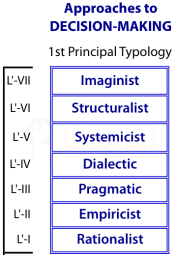
Decision Typology & Its TET
THEE, the Taxonomy of Human Elements in Endeavour, gets its logic and power from human action. It is not a theory of human action, but an observation and categorization of human action looked at from within the person.
The Typology was discovered long before the existence of a comprehensive taxonomy or the possibility of deriving related frameworks was ever imagined. The uncertainty at that time lay not in the constituent Types or the completeness, but in their hierarchical ordering.
The discovery that a Typology of incompatible systems (Types-Methods) could be converted into a Spiral of compatible systems (Modes-Values) occurred in relation to the .

At a very early stage, the TET (Typology Essences Table) was plotted using a common convention in the literature. It took 15 years for me to recognize the psychosocial nature of the axes and incorporate that convention within the taxonomy.
Although the significance of a TET was not understood, it is now apparent that its important features include:
- the axes' names such that: Y-axis = psycho-; X-axis = -social: here task v people
- plotting all the
- identifying the nature of the two diagonal sets:
here LL → UR = systematic , LR → UL = responsive - recognizing the unusual nature of the
Spiral of Management Culture
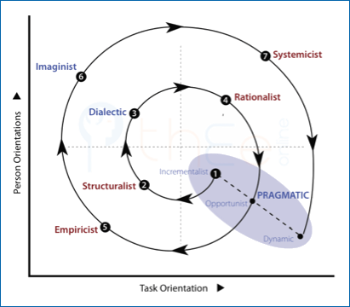
Despite the limitations of my knowledge, I learned from multi-year organizational transformation projects that the was a primary focus for positive change. Once the significance of (and not just any culture) was appreciated, the discovery of the Spiral just fell into my lap.
However, it took a little while to work out all the details and test it in practice. It was more difficult to specify that were not yet common in organizations.
Clients were often disturbed by the incompatibility of the approaches. A significant side-benefit of this discovery was the conversion of incompatibility to compatibility by focusing on:
► the value context of
as distinct from
► the activity content of
Achievement in Organizations

The discovery of a Spiral and awareness of culture had an additional effect. It changed the focus twice:
■ decision → achievement
■ the person → the organization
The Tree implied by the Spiral was identified but never fully developed or published or even properly named. But it was used in consultancy at times. For a thousand reasons, not all of which I would be proud of, the workings of this framework were not given the necessary thought. That is how matters stood for 20 years.
I started work on about a year after completing the modeling of . It was natural to assume that a similar evolution of frameworks would develop. It may perhaps look rather obvious now, but it was not obvious at the outset. It was confusing, as usual.
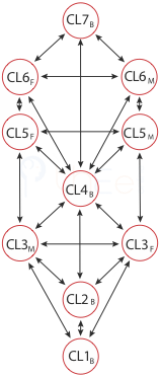
The first step was to get 100% clear about the general context for . It was like one of those primary school math puzzles:
: ??? :: :
I concluded that the unknown value was «».
The other comparable was easier:
: ??? :: :
The unknown here surely has to be «».
So the Tree of the ) was named about twenty years after its discovery.
There were, however, significant improvements in understanding that led to enhancements to the rudimentary Tree. This enhanced clarity was not theoretical. It led to the development of two new frameworks: one for employee achievement within organizations, and the other for entrepreneurial achievement.
Expectations Underpin Achievement
The next step is (for me) the most strenuous and frustrating. It is to create a Structural Hierarchy from the Tree. This is a rather demanding form of structural corroboration .
It was apparent at an early stage that the organizational setting created an extra wrinkle in analysing. It took some time to determine that there were three distinct perspectives in play that must on no account be confused:
● the organization's which was wholly impersonal,
● the employee's which was wholly personal,
● the management's: a personal representative of an impersonal organization
The requirement of the organization, shown at the top of the diagram, had to be interpreted differently by management and by employees: shown at the bottom.
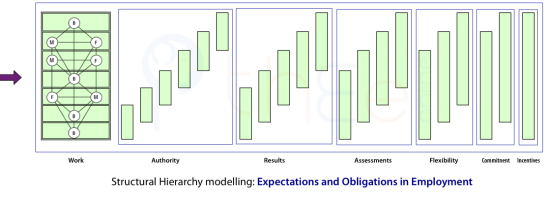
Employment = Relationship
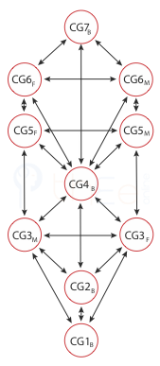
Finally, by homology with , there would have to be a final Tree. One created by turning the Structural Hierarchy on its side and seeing Grouping-1 (CG1) as Level-1, and so on upwards.
The biggest difficulty here was to grasp that this was a and dealt with unavoidable work-related social tensions. It was not about performance. Get the handling of employees right, and performance would follow as night follows day—assuming, of course, that the was being well operated.
Another difference from was the need for two Trees. One Tree for Management, who have to of for the organization. This entails:
● finding and keeping employees
plus
● managing the work they do.
There was also the Tree for Employees, who have to deal with the state of by an organization and working with its . This entails:
● looking after personal interests sensibly
plus
● working hard, effectively and enjoyably.
Final Thought
Much of this journey must have seemed harping on the obvious and even unnecessary, but as Galileo said: "All truths are easy to understand once they are discovered: the point is to discover them."
There is a lot more to discover within THEE's . THEE is still mostly a vast expanse of unknowing.
Originally posted: 23-Dec-2011